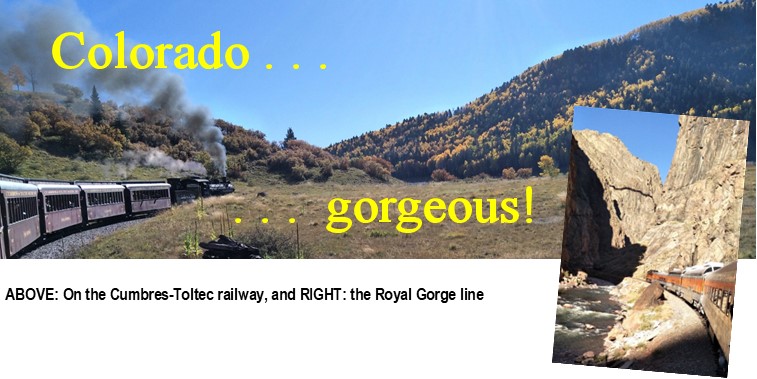
I’ve been procrastinating over this story about my Colorado railway safari for months because, no matter which way I looked at it, pushed, prodded and patted it, the words came out as a travelogue, possibly, I hope, better written than most, but nevertheless like every piece ever written for weekend magazine supplements. I have sought over the years of describing my journeys to add a little value, and in what I was actually writing (and deleting) about this trip nothing was happening.
But I have found the way, or rather it found me. I received in the mail, the actual hard-copy mail, a gift from one of my companions on the Colorado tour. I had been expecting it because a couple of weeks ago Bill e-mailed me asking for my house address but he wouldn’t say why, other than that he had something to send me. On the trip the two of us had mounted a co-operative mission to acquire souvenir lapel badges from the railways we rode and the places we rolled through – so I thought he’d found one we’d missed, or something like that.
Well, no.
What unfolded itself from the padded packet was a neck tie, festooned with little lozenges which, on close inspection, turned out to be Amtrak logos [for any non-trainspotters along for the ride, Amtrak is the United States’ Government-owned passenger train operator]. For years, I’ve been seeking some kind of wearable Amtrak souvenir to commemorate my rail passages across America but none has been forthcoming. I looked for railroad ties in Colorado but, apart from those holding the track together, there weren’t any. They don’t do neck ties in Colorado. Bill knew of my quest, of course, because, well, I have been known to prattle on a bit.
Let me hand over the yarn to Bill, from his covering letter: “On a recent [train] trip . . . I asked the conductor about buying Amtrak attire, specifically neck ties. He indicated none available for purchase. I continued to tell him of you and your quest for train related neck ties and the lack of availability . . . mentioned our Colorado trip, etc. He offered his own uniform tie!”
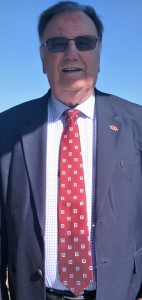 The custodian of the cars duly handed it over, and I received it courtesy of the US Postal Service and Australia Post. This piece of 100 per cent polyester is surprisingly tasteful, especially when compared with some of the souvenir ties I have in my wardrobe, and came complete with small, almost undetectable, spots which if analysed might have revealed the conductor’s liking for hotdogs, mustard and coffee. Bill pressed on this generous train man a small payment for his neckwear, which he accepted (albeit only under strong protest), and so I am not saying what train my friend Bill, and his lovely wife, Debbie, were on, nor where they live, except that it’s in California. I wouldn’t want the meanies at Amtrak to get the idea that any of their loyal employees has discovered a nice little earner in flogging off parts of his apparel to passing proxy Australians. I have proudly worn his tie (shining free of Amtrak refreshments) to my club, where my choice of neck decoration sometimes excites comment, and explained how I acquired it.
The custodian of the cars duly handed it over, and I received it courtesy of the US Postal Service and Australia Post. This piece of 100 per cent polyester is surprisingly tasteful, especially when compared with some of the souvenir ties I have in my wardrobe, and came complete with small, almost undetectable, spots which if analysed might have revealed the conductor’s liking for hotdogs, mustard and coffee. Bill pressed on this generous train man a small payment for his neckwear, which he accepted (albeit only under strong protest), and so I am not saying what train my friend Bill, and his lovely wife, Debbie, were on, nor where they live, except that it’s in California. I wouldn’t want the meanies at Amtrak to get the idea that any of their loyal employees has discovered a nice little earner in flogging off parts of his apparel to passing proxy Australians. I have proudly worn his tie (shining free of Amtrak refreshments) to my club, where my choice of neck decoration sometimes excites comment, and explained how I acquired it.
The kind of thoughtfulness, as shown by Bill, and the spontaneity of spirit flowing from my anonymous benefactor sadly seem not widespread in this brave new world of ours. Yet what has been known as “humanity” for millennia still exists and wonderfully appears every now and then out of the blue, such that the lemming leap gets postponed for a while longer.
Bill is much younger than I – maybe 15-plus years, I don’t know – and, it turns out, was a Boy Scout in his youth (as indeed was I). Good deeds are part of the Scouting ethos, as everyone knows, and the tie gift is not the only kindness he showed me since we first met in the breakfast room at a Denver Holiday Inn. Most spectacularly, he saved me from doing myself serious damage on the first day of our tour.
After half a day on the California Zephyr out of Denver, the six of us in our tour party had piled out of the train into the operator’s van at Glenwood Springs and headed over the mountains towards our first rendezvous with the vintage rail network that criss-crosses Colorado. We stopped at the top of the Continental Divide, 14,000 feet or so above sea level. The air’s a bit thin up there and I miscalculated. The lookout is about 100 metres from the car park, up a slight incline. We were in a hurry because it was late afternoon and our overnight hotel was still many miles away. I charged up the hill, but never reached my goal. Oxygen deprivation kicked in and I had to stop. When the coughing subsided and I could catch a breath, I crept back to our vehicle to wait for the others to return. I had to be content to snap a few photos from there (below).
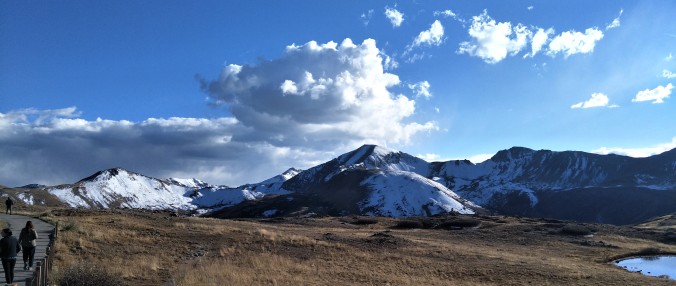
My travails that day, though, were not over. Our stopover destination was Leadville, altitude 10,000 feet, and the century-plus-old Delaware Hotel had been chosen as a vintage treat for us tourists – but it was not equipped with a lift (sorry, elevator). Our rooms were up two flights of steep stairs. I made it with my suitcase and shoulder bag to the first floor but halfway up the second lot of steps I stalled, gasping for breath. I could not make the climb with my case under any circumstances. Suddenly the largish body of Bill bustled up, grabbed my case and deposited it at the peak. I almost literally crawled to the top. I managed to make the ascent of that mini-Everest only once more during our stay, and I had learnt a valuable lesson about working my ancient, unfit (and, as diagnosed when I got back home, asthmatic) carcass at high altitude. Which meant all the time – nowhere in Colorado is below 4000 feet. It is the Mile High State after all.
Bill and Debbie and the rest of our group were concerned about my health but I made it through the tour without much further ado – and was spectacularly rewarded. The travelogue kicks in here, I’m afraid.
I went to Colorado for the trains, and I most certainly had my fill of them. Great rides. The irony of the whole experience, though, was that to reach the trains we had to make a major road trip. You can’t go by train to the trains. Once upon a time the Rio Grande Western railroad ran a mainline passenger service linking the south and east of Colorado to the main transcontinental line on which today’s version of the Zephyr operates. If that had been still operating, we might possibly have reached the preserved tourist railways by train from maybe Glenwood Springs and/or Denver.
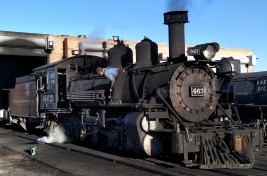 But we couldn’t. Chris, our tour owner/organiser/operator and driver, covered many miles for us – I don’t know how many, but certainly deep in the four figures – to reach the remnants of the narrow-gauge mining railways that track through and over the mountains south of Glenwood Springs, plus the out-and-out tourist railway at Pike’s Peak and another small ride close to Denver. Along the way we had stop-offs at some stunning national parks and a detour west to Monument Valley (see the immediately previous piece in The Traveller).
But we couldn’t. Chris, our tour owner/organiser/operator and driver, covered many miles for us – I don’t know how many, but certainly deep in the four figures – to reach the remnants of the narrow-gauge mining railways that track through and over the mountains south of Glenwood Springs, plus the out-and-out tourist railway at Pike’s Peak and another small ride close to Denver. Along the way we had stop-offs at some stunning national parks and a detour west to Monument Valley (see the immediately previous piece in The Traveller).
I’ll add some notes on the specifics at the end and largely leave you to look them up yourselves on the WWW. I really can’t do better than some of the videos you can click on.
I have to say, though, that no video will do this trip justice for me, because at the end the trains, while giving me everything I wanted, weren’t only what sent me home with lasting memories. It was the place. The physical splendour of the Rocky Mountains and the High Plains, the red deserts and deep canyons was sensually staggering, in the end almost overwhelming. You have to be there to get it. This old man found he still had buried within him a sense of wonder at what his eyes beheld.
A little of this I shared in my yarn about P.G. Wodehouse, Johns Wayne and Ford, and Monument Valley and the Navajo. I titled that piece All America’s a (Sound) Stage because wherever I’ve been on my infrequent forays into the United States I’ve been reminded of movies, and this tour of Colorado, with incursions into Utah, Arizona and New Mexico, was Hollywood all the way. Grand vistas, strange landscapes, cowboy country, Native Americans, only-in-America places, people and oddities, ghost towns and railroads with classic platform-ended passengers cars hauled by smoke-spewing steam engines – my 12 days in Colorado had it all, and BIG. I mean, we do “big” in Australia, no doubt about it, but in Colorado everything is big – big sky, big mountains, big plains, big canyons, big people, big meals. Top Gun country in San Diego, when I got there for the Wodehouse Society convention, seemed small by comparison. I’ve been awed in Switzerland, loved it and never thought that could be surpassed. But Switzerland is chocolate box beautiful – Colorado (and I guess the Rockies generally, up and down North America) is wild, way out of control.
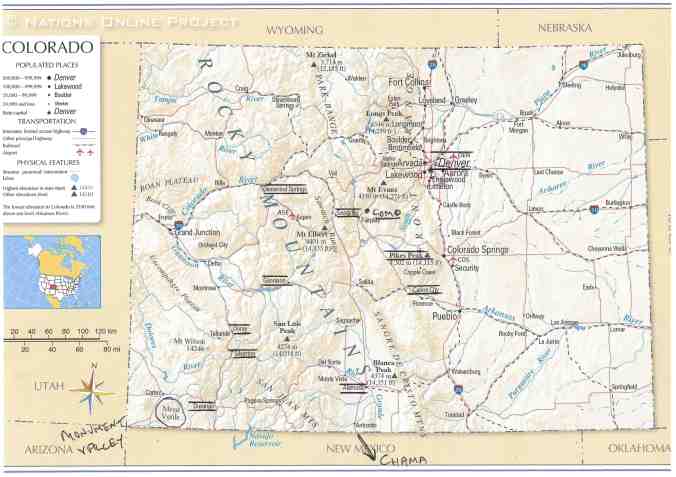
For the record, I’ve traced our journey on the map here. You can see (I hope) I’ve marked the main places we went. We started out in Denver, travelled by Amtrak’s Zephyr to Glenwood Springs, then on the road to Leadville, Colorado Springs (for Pikes Peak), Canon City for the Royal Gorge train, Alamosa and Chama (New Mexico) for the Cumbres-Toltec railroad, way west to Monument Valley, then back to Durango for the Durango-Silverton railroad, and return to Denver via Ouray (on the Millionaires Highway, so called because it was built with gold mine mullock, through the San Juan Mountains), Gunnison and Golden. Along the way we looked in at the Goosenecks State Park in Utah, the Mesa Verde National Park, the Garden of the Gods (near Colorado Springs), Black Canyon in the Gunnison National Park and the Great Sand Dunes National Park near Canon City.
HIGHLIGHTS
Leaving aside the bonus visit to Monument Valley, the three big train rides were worth the price of admission all by themselves. The Royal Gorge ride is only short, on the now disused Rio Grande main line, but spectacular, through a canyon you wouldn’t think you could squeeze a thin man and under the highest suspension (road) bridge in the country. The Durango train takes you on a day-long trip through the mountains from a deadset cowboy town to a vintage (preserved) mining village nestled in among the peaks. The Cumbres-Toltec winds around the hills from one TexMex location to another. The Royal Gorge train is standard-gauge, powered by an old streamliner diesel, and the other two are narrow gauge (3 feet) and powered by meticulously maintained workhorse steam locos. On Royal Gorge and Cumbres-Toltec we were able to ride outside in open wagons (called gondolas in US railroad parlance), which meant we missed nothing. The Silverton train was all inside the vintage, platform-ended carriages – just as well perhaps, because that day was cold and wet. I snapped the picture here the next day when, miraculously, it was fine and sunny.
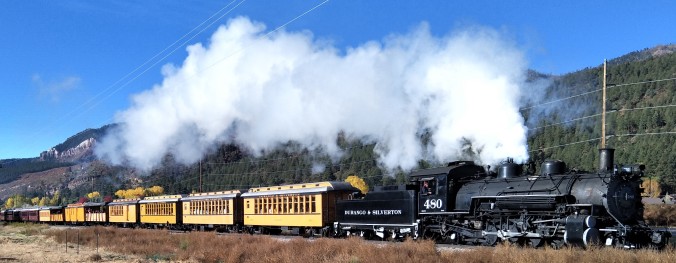 In Durango we stayed at the carefully preserved and renovated Strater Hotel where a honky-tonk pianist was playing in the bar. He knew all the old vaudeville and English music hall songs, plus a few from Australia (where he’d played at a few clubs). Believe it or not, I was not the only Australian in the joint that night – there was a couple from, I think, somewhere in New South Wales. Anyway I had a great singalong, even if nobody joined in.
In Durango we stayed at the carefully preserved and renovated Strater Hotel where a honky-tonk pianist was playing in the bar. He knew all the old vaudeville and English music hall songs, plus a few from Australia (where he’d played at a few clubs). Believe it or not, I was not the only Australian in the joint that night – there was a couple from, I think, somewhere in New South Wales. Anyway I had a great singalong, even if nobody joined in.
Out on the High Plains east of Leadville is an almost ghost town named Como. It’s way off the beaten track but a bunch of rail enthusiasts has restored an old engine shed and station there and stacked it full of memorabilia. They’re working bit by bit on the abandoned hotel. A railroad veteran, grizzled true to the cliché, gave us a tour and a talk – totally fascinating and surprising. The irony, in a land where irony is in short supply, is that Como is now completely isolated from any railroad – linking tracks having been taken up long ago – and it’s in the South Park region. Yes, TV folks, there is a South Park and I’ve been there – no, they did not kill Kenny, at least not that day.
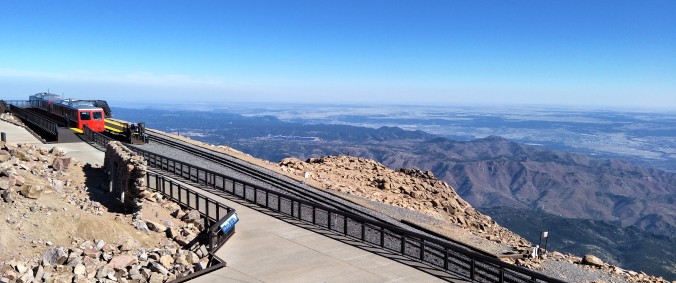 Pike’s Peak (above), I’ve since discovered, is famous around non-trainspotters for car races. Nevertheless I can tell you the recently rebuilt tourist railway (and it was originally constructed for tourists in 1891) up this 14,000ft eminence is also on the money. It’s a fine example of a Swiss-like cog line, and it’s diesel-electric these days, rather than steam. The views from the top are sensational but beware the cold. The wind-chill factor is severe, and I had to retreat to the visitors’ centre toilets to warm my frozen fingers under the hand-dryers.
Pike’s Peak (above), I’ve since discovered, is famous around non-trainspotters for car races. Nevertheless I can tell you the recently rebuilt tourist railway (and it was originally constructed for tourists in 1891) up this 14,000ft eminence is also on the money. It’s a fine example of a Swiss-like cog line, and it’s diesel-electric these days, rather than steam. The views from the top are sensational but beware the cold. The wind-chill factor is severe, and I had to retreat to the visitors’ centre toilets to warm my frozen fingers under the hand-dryers.
The Great Sand Dunes – who would have thought that at the edge of the High Plains, 7000ft up, many miles from the sea, there would be the tallest sand dunes in America – not red as in central Australia but white, like a spectacular beach? Again, way off the beaten track and, if you keep your eyes open while you’re going to and from, you might see some bison grazing. Now protected, these so-called buffalo once filled the plains but settlers and other hunters made them nearly extinct.
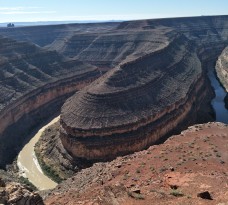 Goosenecks park (right) – the San Juan River cuts a deep, winding path (reflected in the name) through the plateau just over the south-western border in Utah. Bill and Debbie, the only Americans in our tour group, not only had not seen this place (unsurprising – it’s long way from anywhere) but did not even know it existed.
Goosenecks park (right) – the San Juan River cuts a deep, winding path (reflected in the name) through the plateau just over the south-western border in Utah. Bill and Debbie, the only Americans in our tour group, not only had not seen this place (unsurprising – it’s long way from anywhere) but did not even know it existed.
Mesa Verde – it houses a long abandoned but well preserved Native American village of cave dwellings (below) and other houses nestled into the canyons. The peculiar thing is that this ancient habitation is at the top, rather than the bottom, of a mountain.
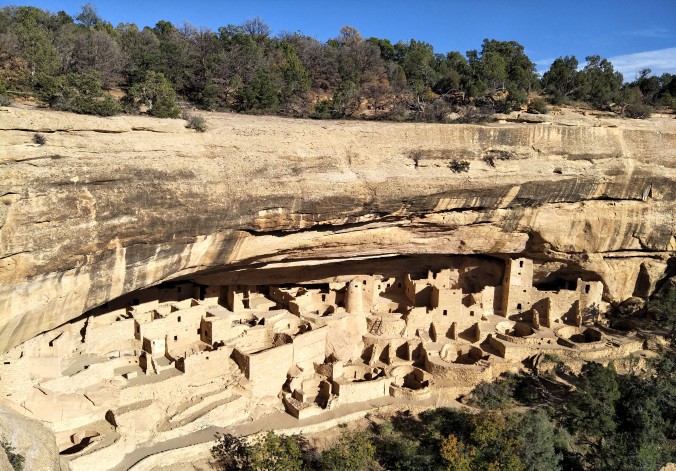 Garden of the Gods – a park of unusual and spectacular rock formations, the first of many such places we saw in our odyssey across southern and western Colorado to Monument Valley and back. I did some homework before I left Australia and found a video [https://www.youtube.com/watch?v=i5QeyztIIT8] which told me that the mountain land we now know as Colorado was once in the Southern Hemisphere and much of it was under the old sea, hence its sedimentary geology in many places, mixed in with volcanics. The rock transformations over eons created the deposits of coal, oil, gold, copper, silver, lead and other minerals that have made Colorado one of the world’s premier mining provinces and forged, as a by-product, the railways I’ve just been enjoying.
Garden of the Gods – a park of unusual and spectacular rock formations, the first of many such places we saw in our odyssey across southern and western Colorado to Monument Valley and back. I did some homework before I left Australia and found a video [https://www.youtube.com/watch?v=i5QeyztIIT8] which told me that the mountain land we now know as Colorado was once in the Southern Hemisphere and much of it was under the old sea, hence its sedimentary geology in many places, mixed in with volcanics. The rock transformations over eons created the deposits of coal, oil, gold, copper, silver, lead and other minerals that have made Colorado one of the world’s premier mining provinces and forged, as a by-product, the railways I’ve just been enjoying.
On arrival at Denver airport, I was trying to figure out how to extract a ticket from a machine for the train ride into the city 25 miles away, when a young couple gave me one. They were heading for a flight and had this one left over, for some reason. This was a great start to my dozen days in Colorado. Indeed, people everywhere were friendly, helpful and cheerful (except for a female person I mention below). And the first music I heard booming at me from some remote radio was that of those old Oz rockers, AC/DC.
A light-footed waiter in a Denver restaurant on the last night of the tour decided he needed to show off to this mixed party of Americans and exotic fauna. He was a tall man, way over 180cm and well built with it. He danced around us like Nijinsky on speed and capped the display off by pouring wine from above his head into glasses held waist-high – and never spilling a drop.
LOWLIGHTS
Inevitably, in a trip of this magnitude, there were disappointments, though nothing to spoil anything, and nothing for which to reproach our tour provider. For me, but not for others, the food just about everywhere was less than toothsome. I was hoping to sample some good TexMex tucker but what was on offer seemed to me mediocre (even in San Diego later). At breakfast at a bakery in Durango I asked the waiter for a Danish pastry. He looked blankly at me: “What’s that?” But the cake was taken by the Chinese restaurant in Leadville – both the physical surrounds and the food were awful. No one would dissent from that, I’m sure. We went there because basically it was the only place open on a Sunday night, but I was content with that because I reckon you can rely on Chinese in country towns (in Australia anyway) and in old mining communities. It seems to me that, when in America, stick to hamburgers.
We stopped for lunch one day, in a place called Buena Vista, a one-time thriving mining town but now given over to tourism, and I went for a stroll down the street. A youngish mom trying to marshal two small children took time out to berate me for walking on the wrong side of the footpath. I didn’t keep to the right as they do in America. Nor did her kids, by the way, but so what? There wasn’t anyone else on the street.
I have just learnt from my latest TRAINS magazine, we missed railway-connected craft breweries in Durango and Denver. Steam Engine Lager in Durango features the Durango-Silverton railroad on its cans. In Denver, I’m told, the Wynkoop “brewpub”, which serves Railyard Ale, is right across the road from Denver’s Union Station. I don’t drink beer much these days but I would have sampled these, just for fun.
Taxis seem to have disappeared from Denver. I arrived by train from the airport at Union Station and had to get to my hotel on the other side of the CBD – about a mile, I guess. It was Saturday afternoon and the place was humming (the station is now mostly shops, eating places and a hotel). Not a taxi in sight, despite the crowds – so there was nothing for it but to take Shank’s pony, trailing my suitcase behind me. Luckily I travel light.
On the way out of Colorado, I left my passport on the check-in counter at Denver Airport and didn’t know it until the booking agent chased me down before I got out of sight in the massive crowds. I literally felt sick at this near-miss and succumbed to a nervous asthmatic coughing fit which subsided eventually but did not disappear. I coughed my way behind a padded-up hankie through my flight until I again reached sea level in San Diego.
And, on that note . . . th-th-that’s all, folks.
Clearly a beaut trip and well described thanks Noel, though a pity both sights and heights left you breathless. Hopefully you will soon be seen at your club sporting your splendid new and stainless neck sleeper so that we may tie one on in salubrious company.
Yours in continuing turkeyfoodling and now mountain class ferroequinology,
Prolix Palmer.
LikeLike